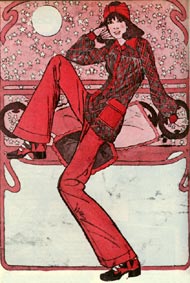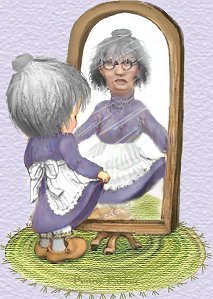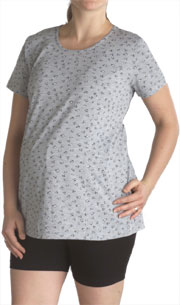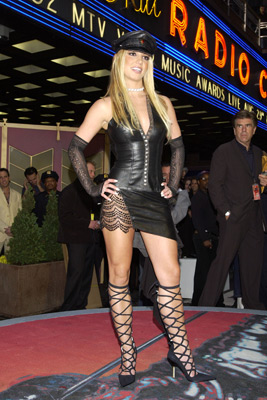Whether we like it or not, clothing speaks volumes. More specifically, it
represents a system of signs,not unlike language, or facial and gestural expressions
(Branston, 1997). Fashion is a means by which we have learned to recognize
and organize our thoughts about others. And like any other signifying system,
its meanings vary between individuals, generations, and across cultures.
 |
|
This is not so surprising when we examine the extent to which fashion reflects a grander cultural construct. To wit, youth and beauty are themselves impermanent aspects of life, and yet remain of utmost importance, especially for women. But even this norm has its limits.
As a culture, we have agreed upon certain standards of dress contingent upon age. Young women, or maidens, are expected to flaunt their near-flawless bodies, but with a tasteful balance, so as to not appear licentious. During pregnancy, mothers are clad in bright but unflattering maternity clothing. Post-pregnancy, sweats and jeans and oversized t-shirts reign, since Mum’s undying dedication to her children prevents her from spending time on herself. Older women, or crones as we affectionately say, are expected to cover up their sagging skin, and varicose veins, and if they don’t, it’s to the fashion police they go, where the tell-all words are unleashed, “DRESS YOUR AGE!”
We’ve heard this phrase so often, it’s nearly inextricable from our fashion vocabulary. And while it purports acceptance of women at their different age groups, it is actually deeply rooted in the cultural construct of unattainable youth and beauty.
Ergo, older women must conceal their bodies, since they are no longer young and supple. Fashionable options for the crony crowd include: long skirts with pantyhose, conveniently rolled just below the knees (the sort of doughnuts homer Simpson avoids), mumus, sweaters during all weather, and on that note, turtlenecks are preferable since gratuitous waddles are never a pretty sight on women (yet on men, theyare exquisite). And if the sweaters must come off, for a swim, say, one-piece bathing suits are acceptable, and an additional frilly skirt is preferable. Bathing caps are optional.
While pregnant, mothers are glowing images of perfection. Even though their clothing tends to be frumpy and unflattering, Mummy-to-be better look as radiant and chipper as the day her little one pops out... This includes, and is only socially limited to: matching button down shirts and leg warmers. neon pink or purple are choice colors. Several layers of brightly colored socks may be added for accent... and to prove that Mom can still touch her feet! Polka-dot shifts, just skimming the knees are acceptable, too: Mum may be pregnant, but she can still show some skin- so long as she’s under forty, that is.
Once the baby’s out, Mom can lose the bright and sunny act, and start getting real... frumpy, that is. Warm-up suits are her number one choice, since she no longer has time to primp. Besides, now that baby is born, mum has fulfilled her child-bearing duties, and no longer needs to dress to impress. Instead, since her identity is now synonymous with her child’s, she projects her fashion-sense onto junior/ jouniour-ette, who in now clad head to toe in blue or pink, respectively.
Young women, it seems, are blessed (or cursed) with the most diverse clothing options. Or are they? So long as maidens are objects of desire, the skirts are short, and the tops tight and cropped. Then again, should they appear too palatable, they may risk forcing a young man to borrow their purity... and never give it back! So the question is: Britney Spears, or get thee to a nunnery?
As it happens, the princess of pop answered this herself several years back with her school-girl-erotica. Clad in a short plaid skirt, pig-tails, and a shirt tied above her naval, Britney Spears embodied the ultimate juxtaposition of naughty and nice: “I’m so hot, you can’t touch me!” Certainly the media has enjoyed covering Britney’s fashion choices as if she’s a bonafide revolutionary: the Che Guevara of bubble gum pop. This is not so accurate when we acknowledge that by exposing her body while presenting an image of youthful innocence, she is only upping the ante on an age old stereotype that engenders the sexy-virgin dichotomy. It seems, then, that when it comes to fashion, girls and women can’t win. Older women are discouraged from their own bodies thanks to a cultural infatuation with youthful beauty. Mothers must first appear luminous while babies are in utero, and then not fuss too excessively thereafter, as the effort might represent selfishness, and as it follows, bad mothering. Young women must appear simultaneously sexy and pure, so as to reaffirm an unattainable beauty standard.
So how do we make it all work? Clothing is a huge part of social living, and even necessary (arguably so in California). The human tendency to extract meaning from fashion is also unavoidable. How do we dress, then, to speak, without reaffirming a fashioned- pun intended- code of dress? First, I’d like to tell a story, and then I leave it to you, the reader, to decide.
As a high school student, I attended a pretentious prep school on the east coast, that inflicted a rather bothersome dress code: (paraphrase) “blazers must be worn at all times, along with turtlenecks, or other sweaters that minimize skin exposure. Jeans are not to be worn, except for on casual dress days- my freshman year, I recall, we had none-, slacks must be fashioned to fit (no baggy trousers), and students must embrace an overall tidy appearance (brush your hair, wash your clothes, buy them at j crew).
Having grown up in California, the Bay Area, to be exact, and having exercised my right to visit Telegraph Ave in Berkeley for my shopping needs, I was by no means prepared for Exeter’s dress standards. So I did what I could to evade not only what I perceived to be restrictive regulations, but also truly repulsive aesthetics(shoulder-padded blazers and tapered jeans!?! non merci!). if you like, I did it for art.
For example, despite grueling winds, and below freezing temperatures, I insisted upon donning a pair of mint green polyester pants. Their length suggested pairing with platform heels (as appropriate for the era), but I smartly wore them with my flat silver and black vans, in the snow, nearly everyday. Meanwhile, I ported a sunburst yellow wool sweater, courtesy of my grandmother’s closet, also poorly suited to New Hampshire weather, which I covered with a thin black bomber jacket...
Back then, bomber jackets were no hipper than your grandpa’s dusty war gear- and in all likelihood they were one and the same. Polyester was still in the closet, thanks to post disco anxieties, and let’s not forget that grunge was like, way in, so bright sunny yellow was like, way out. In sum, I was a black-and-yellow-and-polyester sheep in herd of navy-blazer-clad lambs. I was often cold, but it was suffering worth bearing: It was my fourteen year old rebellion.
By no means am I encouraging impractical fashion sensibilities. I am well aware that my stubbornness caused massive damage to my precious silver vans, as well as to the eyes of my schoolmates. I intend only to posit an alternative to the standards that society implicates as normal, and seemingly unavoidable. Fashion does not need to be another oppressive force in women’s lives, quite the contrary, it can be entertaining and even empowering.
In sum, we are all free to dress how we like, and not according to our ages. On that note, may I offer one slice of fashionista wisdom:
This is a bad idea at any age. Always.



